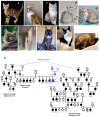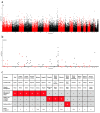Different Founding Effects Underlie Dominant Blue Eyes (DBE) in the Domestic Cat
- PMID: 38997957
- PMCID: PMC11240321
- DOI: 10.3390/ani14131845
Different Founding Effects Underlie Dominant Blue Eyes (DBE) in the Domestic Cat
Abstract
During the last twenty years, minimal white spotting associated with blue eyes was selected by feline breeders to create the Altai, Topaz, and Celestial breeds. Additionally, certain breeders introduced this trait in their lineages of purebred cats. The trait has been called "dominant blue eyes (DBE)" and was confirmed to be autosomal dominant in all lineages. DBE was initially described in outbred cats from Kazakhstan and Russia and in two purebred lineages of British cats from Russia, as well as in Dutch Maine Coon cats, suggesting different founding effects. We have previously identified two variants in the Paired Box 3 (PAX3) gene associated with DBE in Maine Coon and Celestial cats; however, the presence of an underlying variant remains undetermined in other DBE breeding lines. Using a genome-wide association study, we identified a single region on chromosome C1 that was associated with DBE in British cats. Within that region, we identified PAX3 as the strongest candidate gene. Whole-genome sequencing of a DBE cat revealed an RD-114 retrovirus LTR (long terminal repeat) insertion within PAX3 intron 4 (namely NC_018730.3:g.206975776_206975777insN[433]) known to contain regulatory sequences. Using a panel of 117 DBE cats, we showed that this variant was fully associated with DBE in two British lineages, in Altai cats, and in some other DBE lineages. We propose that this NC_018730.3:g.206975776_206975777insN[433] variant represents the DBEALT (Altai Dominant Blue Eye) allele in the domestic cat. Finally, we genotyped DBE cats from 14 lineages for the three PAX3 variants and showed that they were not present in four lineages, confirming genetic heterogeneity of the DBE trait in the domestic cat.
Keywords: DBE; Waardenburg syndrome; coat colour; deafness; eye; feline; hair; pigmentation; white spotting.
Conflict of interest statement
The authors declare that they have no competing interests. Antagene and Generatio are for-profit societies selling DNA tests for animals. The funders had no role in the design of the study; in the collection, analyses, or interpretation of the data; in the writing of the manuscript; or in the decision to publish the results.
Figures


Similar articles
-
Dominant blue eyes in Maine Coon cats: New PAX3 variant and updated phenotypic data.Anim Genet. 2025 Jun;56(3):e70020. doi: 10.1111/age.70020. Anim Genet. 2025. PMID: 40459211 Free PMC article.
-
A PAX3 insertion in the Celestial breed and certain feline breeding lines with dominant blue eyes.Anim Genet. 2024 Aug;55(4):670-675. doi: 10.1111/age.13433. Epub 2024 Apr 22. Anim Genet. 2024. PMID: 38644700
-
PAX3 haploinsufficiency in Maine Coon cats with dominant blue eyes and hearing loss resembling the human Waardenburg syndrome.G3 (Bethesda). 2024 Sep 4;14(9):jkae131. doi: 10.1093/g3journal/jkae131. G3 (Bethesda). 2024. PMID: 38869246 Free PMC article.
-
[RD-114 virus story: from RNA rumor virus to a useful viral tool for elucidating the world cats' journey].Uirusu. 2016;66(1):21-30. doi: 10.2222/jsv.66.21. Uirusu. 2016. PMID: 28484175 Review. Japanese.
-
Pleiotropic effects of coat colour-associated mutations in humans, mice and other mammals.Semin Cell Dev Biol. 2013 Jun-Jul;24(6-7):576-86. doi: 10.1016/j.semcdb.2013.03.014. Epub 2013 Apr 9. Semin Cell Dev Biol. 2013. PMID: 23583561 Review.
Cited by
-
Dominant blue eyes in Maine Coon cats: New PAX3 variant and updated phenotypic data.Anim Genet. 2025 Jun;56(3):e70020. doi: 10.1111/age.70020. Anim Genet. 2025. PMID: 40459211 Free PMC article.
References
-
- David V.A., Menotti-Raymond M., Wallace A.C., Roelke M., Kehler J., Leighty R., Eizirik E., Hannah S.S., Nelson G., Schäffer A.A., et al. Endogenous retrovirus insertion in the KIT oncogene determines white and white spotting in domestic cats. G3. 2014;4:1881–1891. doi: 10.1534/g3.114.013425. - DOI - PMC - PubMed
Grants and funding
LinkOut - more resources
Full Text Sources
Miscellaneous

